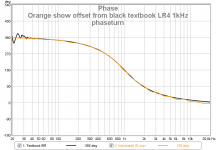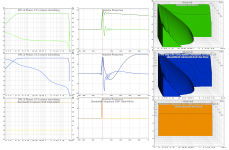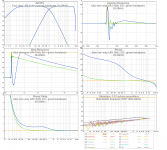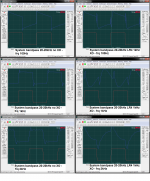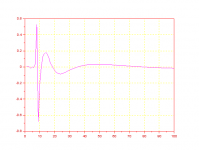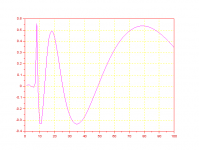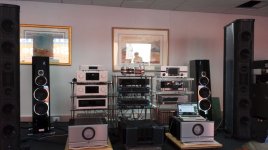P.S. You could bring over the B&W's to compare 😉 We'd need a huge curtain to hide the speakers from sight though. 🙂
You must have edited this after my post. Anyway, believe me I can pick out my Sig800 over that bookshelf DIY speaker.
Nevertheless I agree with you that speakers sound very much alike at a certain level.
But you can't get a 20-30K speaker then compare it to a 1-2K speaker even though both full range and believe for a second you won't be able to identify it in a proper setup.
You need to have electronics that are capable of bringing up to light every single aspect of the reproduction being played through them. At the point, every difference will appear clearer and spending 30-40K for a speaker will make more sense to you too!

It's very mysterious how some crossovers and drivers sound good and others don't. I haven't cracked it myself. Just keep building and listening! 😀
BW1 and BW3 are not flat on axis when time aligned. There is a 3dB peak at crossover. But when you put the drivers at 90 degrees phase difference by various means, they are flat on axis, and better to the sides too. But then lobe vertically unless MTTM, in which case they comb. But overall they have more power at crossover, and hence you don't hear the hole in the power response in the room which LR2 and LR4 have.
Now interestingly, all the transient perfect speakers, outside digital (DSP) techniques which can reverse the arrow of time, are 90 degree quadrature types, polynomials of complex variable jwt. There's quite a few ways to do it, including asymettric slopes and even nulls at crossover. So I do wonder if you are hearing the butterworth flat power response, more than the transient perfect itself. I find flat room power response extremely easy to pick out. It's what you hear that sounds good down the hallway.
Shallow slopes usually mean more distortion. Easier with three ways, of course. Most good shallow slope speakers need very complex equalisation.
BW1 and BW3 are not flat on axis when time aligned. There is a 3dB peak at crossover. But when you put the drivers at 90 degrees phase difference by various means, they are flat on axis, and better to the sides too. But then lobe vertically unless MTTM, in which case they comb. But overall they have more power at crossover, and hence you don't hear the hole in the power response in the room which LR2 and LR4 have.
Now interestingly, all the transient perfect speakers, outside digital (DSP) techniques which can reverse the arrow of time, are 90 degree quadrature types, polynomials of complex variable jwt. There's quite a few ways to do it, including asymettric slopes and even nulls at crossover. So I do wonder if you are hearing the butterworth flat power response, more than the transient perfect itself. I find flat room power response extremely easy to pick out. It's what you hear that sounds good down the hallway.
Shallow slopes usually mean more distortion. Easier with three ways, of course. Most good shallow slope speakers need very complex equalisation.
You must have edited this after my post. Anyway, believe me I can pick out my Sig800 over that bookshelf DIY speaker.
Nevertheless I agree with you that speakers sound very much alike at a certain level.
But you can't get a 20-30K speaker then compare it to a 1-2K speaker even though both full range and believe for a second you won't be able to identify it in a proper setup.
You need to have electronics that are capable of bringing up to light every single aspect of the reproduction being played through them. At the point, every difference will appear clearer and spending 30-40K for a speaker will make more sense to you too!
Who's calling my speakers bookshelves 😀

-3 dB points are 17 Hz to 18 KHz to make it clear they are no bookshelves in nature. SPL limit I cannot test without disturbing everything in the room.
I wouldn't call my speakers cheap though. If I had to recreate them for someone interested you'd be looking at ~ € 25.000.00
A lot of labour (and engineering) went into this project to get what I wanted. Part's weren't cheap either, but nearly everything was hand made by me.
It's very mysterious how some crossovers and drivers sound good and others don't. I haven't cracked it myself. Just keep building and listening! 😀
BW1 and BW3 are not flat on axis when time aligned. There is a 3dB peak at crossover. But when you put the drivers at 90 degrees phase difference by various means, they are flat on axis, and better to the sides too. But then lobe vertically unless MTTM, in which case they comb. But overall they have more power at crossover, and hence you don't hear the hole in the power response in the room which LR2 and LR4 have.
Now interestingly, all the transient perfect speakers, outside digital (DSP) techniques which can reverse the arrow of time, are 90 degree quadrature types, polynomials of complex variable jwt. There's quite a few ways to do it, including asymettric slopes and even nulls at crossover. So I do wonder if you are hearing the butterworth flat power response, more than the transient perfect itself. I find flat room power response extremely easy to pick out. It's what you hear that sounds good down the hallway.
Shallow slopes usually mean more distortion. Easier with three ways, of course. Most good shallow slope speakers need very complex equalisation.
I have no crossovers and lately, after a different procedure of using my FIR filters it sound very good even down the hallway (*). As far as I could measure my speakers distortion isn't a concern. Obviously there will be comb filtering... that's another discussion 🙂.
(*) Shortened the correction window that is used to calculate the FIR filters.
Last edited:
A line array is a very nice way to do things, and with some equalisation is a nice solution. I've always liked the sound. Well, PA systems have often used 8 drivers in a line for speech. It works and carries well. Combing? Can never hear it myself. 😀
Tekton are going somewhat in that direction with this bargain MMTTT using SB ring radiators and Eminence high Qms basses:
http://www.stereophile.com/content/tekton-design-enzo-xl-loudspeaker.
Amazing that three tweeters in a row is considered patentable! 🙄
And because I do occasionally get it right, I see the Dunlavy WMTMW transient prefect has the predictable varying relative level over distance problems with the single tweeter relative to the twinned drivers:
Dunlavy Audio Labs SC-IV/A loudspeaker FollowUp part 2 | Stereophile.com
Tekton are going somewhat in that direction with this bargain MMTTT using SB ring radiators and Eminence high Qms basses:
http://www.stereophile.com/content/tekton-design-enzo-xl-loudspeaker.
Amazing that three tweeters in a row is considered patentable! 🙄
And because I do occasionally get it right, I see the Dunlavy WMTMW transient prefect has the predictable varying relative level over distance problems with the single tweeter relative to the twinned drivers:
Dunlavy Audio Labs SC-IV/A loudspeaker FollowUp part 2 | Stereophile.com
The above system does use EQ, both IIR and FIR. It's the one from this step previously posted here in this thread:

Measured at the listening position 3 meter from the speaker in a lively living room. Note the time scale at the bottom (crossing the zero at 15 ms) and compare it to the Dunlavy example ....
In all honesty this Dunlavy speaker was measured to close to show it's true STEP response.

Measured at the listening position 3 meter from the speaker in a lively living room. Note the time scale at the bottom (crossing the zero at 15 ms) and compare it to the Dunlavy example ....
An externally hosted image should be here but it was not working when we last tested it.
In all honesty this Dunlavy speaker was measured to close to show it's true STEP response.
Who's calling my speakers bookshelves 😀

.
Indeed they are shelves, not bookshelves but speakershelves! Hmm, maybe speakersfromhell, depending on loudness😱)
Peter
Indeed they are shelves, not bookshelves but speakershelves! Hmm, maybe speakersfromhell, depending on loudness😱)
Peter
After seeing a picture of them without drivers someone called it a wine rack...
I tried, but it didn't quite fit right...

After seeing a picture of them without drivers someone called it a wine rack...
I tried, but it didn't quite fit right...

Ahh, it looks marvellous, just delay them with some Beajoulaise on the outer bottles and finish in the middle with Barrique😱)
Peter
I think people do get caught up in this transient perfect argument. That's not to say there isn't some merrit to it but it's largely impractical for most situations.
Most combinations of drivers won't work well with the types of filters required and most audiophile offerings are no different in the way they are put together.
The only way to realistically approach the situation is to use a DSP to linearise the end system. This is not audiophile friendly.
For what it's worth I do a lot of listening on headphones, have small full range systems and large multi way systems and can't say I've ever noticed anything particularly special about the single driver systems.
Most combinations of drivers won't work well with the types of filters required and most audiophile offerings are no different in the way they are put together.
The only way to realistically approach the situation is to use a DSP to linearise the end system. This is not audiophile friendly.
For what it's worth I do a lot of listening on headphones, have small full range systems and large multi way systems and can't say I've ever noticed anything particularly special about the single driver systems.
Attached is two IR-wav files than if linked from a computer players convolution engine will add phase turn as a LR4 1kHz XO do without any change to frq response. Think best be run on headphones as green plot traces below or small simple full rangers and play some old Deep Purple tracks : )
Plots electric filters made by looping soundcard digital I/O and listening with REW and TrueRTA via JRivers virtual soundcard device. At present PC routing hinders use of ASIO so REW then limits bandwidth to 16bit/48kHz and can be seen by little steeper slopes than textbook up in top octave.
Admit there a little bit offset in the attached IR-wav files compared a textbook one as seen in first picture but guess is alright, reason is the phaseturn is made by Rephase's "Paragrahic Phase EQ" sliders.
Green plots should virtualize approx a set of heaphones domain with system bandwidth 20-20kHz and blue how a two way LR4 1kHz XO compare to a same system bandwidth. Orange is just to show data of DSP engine loop with no filters set.
Plots electric filters made by looping soundcard digital I/O and listening with REW and TrueRTA via JRivers virtual soundcard device. At present PC routing hinders use of ASIO so REW then limits bandwidth to 16bit/48kHz and can be seen by little steeper slopes than textbook up in top octave.
Admit there a little bit offset in the attached IR-wav files compared a textbook one as seen in first picture but guess is alright, reason is the phaseturn is made by Rephase's "Paragrahic Phase EQ" sliders.
Green plots should virtualize approx a set of heaphones domain with system bandwidth 20-20kHz and blue how a two way LR4 1kHz XO compare to a same system bandwidth. Orange is just to show data of DSP engine loop with no filters set.
Attachments
Last edited:
I've done comparisons like that before. Someone posted sound clips a while back of the standard recording, then of the recording convolved with what would amount to 2nd order, 4th order etc filters imposed upon it. The amplitude remained (obviously) unchanged but the phase went through the usual shifts. Could I hear any difference? Not a thing.
Agreed. Using the convolver in foobar2000, I hear no difference when switching the LR impulse in and out. Same goes for the impulse response and associated step response shown below. This is from a real 3-way system, adjusted slightly to have a flat frequency response.
From which I would conclude that it is not the transient response, but something to do with the radiation pattern and power response that is audible with transient-perfect implementations.
From which I would conclude that it is not the transient response, but something to do with the radiation pattern and power response that is audible with transient-perfect implementations.
Attachments
I've done comparisons like that before. Someone posted sound clips a while back of the standard recording, then of the recording convolved with what would amount to 2nd order, 4th order etc filters imposed upon it. The amplitude remained (obviously) unchanged but the phase went through the usual shifts. Could I hear any difference? Not a thing.
I kind of tent to believe what you are saying...therefore my question really is........what are we really sensitive to?
Amplitude distortion cannot really be heard...impulse response same....then what do we hear that makes us identify a sound better than another?
Who's calling my speakers bookshelves 😀

-3 dB points are 17 Hz to 18 KHz to make it clear they are no bookshelves in nature. SPL limit I cannot test without disturbing everything in the room.
I wouldn't call my speakers cheap though. If I had to recreate them for someone interested you'd be looking at ~ € 25.000.00
A lot of labour (and engineering) went into this project to get what I wanted. Part's weren't cheap either, but nearly everything was hand made by me.
I have no crossovers and lately, after a different procedure of using my FIR filters it sound very good even down the hallway (*). As far as I could measure my speakers distortion isn't a concern. Obviously there will be comb filtering... that's another discussion 🙂.
(*) Shortened the correction window that is used to calculate the FIR filters.
there was a misunderstanding from my side...there was a post with a diy bookself speaker....someone else must have posted that and for some unknown reasons I thought it was you....
obviously your speakers are less bookshelf type than mine.
Did you build those??????
Just a question: what are you driving these with? Are the electronics on the pictures your main one?
You can definitely hear a difference with real speakers and not headphones playing convolved IR's. It is specific to simply recorded, minimally post-produced live recordings where there are percussives like drum kits with rim shots, cymbals, snares, tom toms, stand up bass, piano. Pop, vocals, metal, classical, hip hop - you won't notice anything. Most noticeable for me is a live recorded jazz trio from a nightclub. I can tell that there is a difference because I can load a LR XO in miniDSP and switch back and forth pretty quickly for A/B.
I mean think about it, if a signal is supposed to be a single clean clack like two blocks of wood clapping, what do you think you will hear when there are several reverbrations of peaks like this:
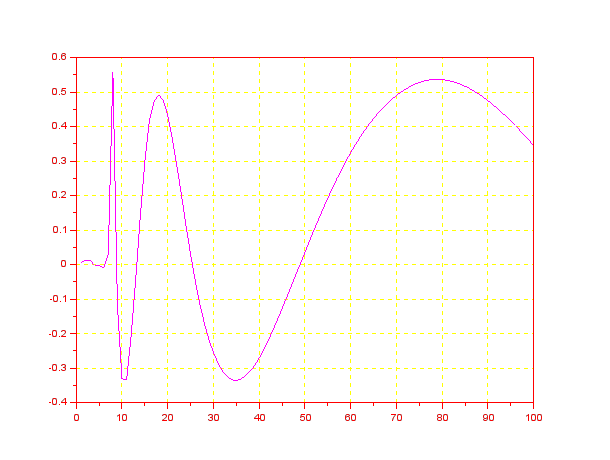
vs a single pulse IR and right triangle SR?
A good test song sample that demonstrates this is from Chick Corea's Trilogy, track 3 on disc 1 "This Song is You".
https://www.youtube.com/watch?v=c-Y9Vevac_s
It sounds wonderful and live when played on transient perfect speakers.
Going back to my analogy, if one has never heard a transient perfect speaker in person (and a small full range is close but lacks the authoritative bass that a transient perfect multiway has so the visceral impact is very different), and saying it isn't audible is like a person who has only seen PAL/NTSC CRT TV saying that 1920p HDTV is not any better than without actually seeing a HDTV in person. We all remember the first time we witnessed an HDTV for the first time.
I mean think about it, if a signal is supposed to be a single clean clack like two blocks of wood clapping, what do you think you will hear when there are several reverbrations of peaks like this:

vs a single pulse IR and right triangle SR?
A good test song sample that demonstrates this is from Chick Corea's Trilogy, track 3 on disc 1 "This Song is You".
https://www.youtube.com/watch?v=c-Y9Vevac_s
It sounds wonderful and live when played on transient perfect speakers.
Going back to my analogy, if one has never heard a transient perfect speaker in person (and a small full range is close but lacks the authoritative bass that a transient perfect multiway has so the visceral impact is very different), and saying it isn't audible is like a person who has only seen PAL/NTSC CRT TV saying that 1920p HDTV is not any better than without actually seeing a HDTV in person. We all remember the first time we witnessed an HDTV for the first time.
5th element
shc
First hour after started listening a LR2 500Hz XO linearized i thought hmm was that it, then started doing something else and later that evening had to raise my head because it got better and better, story now is can't live with out. After a month with the linearized XO tried flatten system high pass too but thought it was too track dependent but later when got a better integration of low roll off slope to suit my room that system high pass is turned on all time and track dependency is gone. Surprised you could hear not a thing, maybe later if convenient give it a try over hours.
Good points and lot of great gear that output exactly what they see at input then why not speakers : )
shc
First hour after started listening a LR2 500Hz XO linearized i thought hmm was that it, then started doing something else and later that evening had to raise my head because it got better and better, story now is can't live with out. After a month with the linearized XO tried flatten system high pass too but thought it was too track dependent but later when got a better integration of low roll off slope to suit my room that system high pass is turned on all time and track dependency is gone. Surprised you could hear not a thing, maybe later if convenient give it a try over hours.
.....You need to have electronics that are capable of bringing up to light every single aspect of the reproduction being played through them. At the point, every difference will appear clearer and spending 30-40K for a speaker will make more sense to you too!
Good points and lot of great gear that output exactly what they see at input then why not speakers : )
You can definitely hear a difference with real speakers and not headphones playing convolved IR's. It is specific to simply recorded, minimally post-produced live recordings where there are percussives like drum kits with rim shots, cymbals, snares, tom toms, stand up bass, piano. Pop, vocals, metal, classical, hip hop - you won't notice anything. Most noticeable for me is a live recorded jazz trio from a nightclub. I can tell that there is a difference because I can load a LR XO in miniDSP and switch back and forth pretty quickly for A/B.
I mean think about it, if a signal is supposed to be a single clean clack like two blocks of wood clapping, what do you think you will hear when there are several reverbrations of peaks like this:
[snip]
vs a single pulse IR and right triangle SR?
A good test song sample that demonstrates this is from Chick Corea's Trilogy, track 3 on disc 1 "This Song is You".
https://www.youtube.com/watch?v=c-Y9Vevac_s
It sounds wonderful and live when played on transient perfect speakers.
Going back to my analogy, if one has never heard a transient perfect speaker in person (and a small full range is close but lacks the authoritative bass that a transient perfect multiway has so the visceral impact is very different), and saying it isn't audible is like a person who has only seen PAL/NTSC CRT TV saying that 1920p HDTV is not any better than without actually seeing a HDTV in person. We all remember the first time we witnessed an HDTV for the first time.
I think the impulse response gives a better idea of what a clack might sound like than the step response does. Anyway, I tried pink PN noise, single-sample impulses (a 1 followed by 11000 zeros at 44.1 kHz) and the track you recommended (which is rather good - thank you), on headphones (Grados that do a fair impression of transient-perfect) and speakers. I cannot hear any difference between the original and convolved synthetic signals when switching back and forth every couple of seconds. I cannot reliably hear any difference with the Corea track when looping short sections and switching when the loop restarts.
Perhaps I'm deafer than I thought.
I think the impulse response gives a better idea of what a clack might sound like than the step response does. Anyway, I tried pink PN noise, single-sample impulses (a 1 followed by 11000 zeros at 44.1 kHz) and the track you recommended (which is rather good - thank you), on headphones (Grados that do a fair impression of transient-perfect) and speakers. I cannot hear any difference between the original and convolved synthetic signals when switching back and forth every couple of seconds. I cannot reliably hear any difference with the Corea track when looping short sections and switching when the loop restarts.
Perhaps I'm deafer than I thought.
Thanks feedback on test, because you listened via good headphones hope okay to ask are you shure DSP engine starts any convolution in stereo, mayby check by measure Foobars output.
From which I would conclude that it is not the transient response, but something to do with the radiation pattern and power response that is audible with transient-perfect implementations.
Practical experience leads me to agree with this too.
I would add to that that similarly transient imperfect speakers with differing power responses all sound very different on the usual percussion / hand clap tests.
I've just returned from an interesting listening session where four excellent speakers were compared. The Wilson Alexia's sounded most life-like in the mids but the panel of audiophile listeners preferred the more laid back Gryphon Trident II's. The least preferred speaker was the Tidal Contriva G2, which boasts "extremely linear frequency response, excellent step response, optimised phase and group delay".
I'm not dismissing the idea that transient-perfect is without merit, but experience tells me that many of the myriad of other imperfections that plague speakers, regardless of price, are perhaps of greater importance.
Btw, we have many fine wines here down-under too. This excellent 1996 vintage Barossa Shiraz for instance went very well with Mssrs Gryphon and Wilson.
Attachments
Last edited:
Just viewing the picture I guessed the Gryphon had the best chance to actually be closest to phase linear behaviour. The arced baffle, similarities to the Dunlavy speakers, their connection to Duelund and the research of Steen Duelund.
This is what Gryphon says about the Trident II's:
While it's not a linear phase claim in words and they show no measurements it remains open what it really means.
This is what Gryphon says about the Trident II's:
Source: Gryphon Trident IIConstant Phase
While constant phase has been acknowledged as a theoretical ideal for several decades, making that lofty goal a practical reality demanded lateral thinking and numerous labour-intensive, custom-built components specially designed by Gryphon in close collaboration with the manufacturers of some of the world’s finest drivers.
Living up to the extraordinary standards that set Gryphon loudspeakers in a class all their own, he Gryphon Trident II incorporates specially developed constant phase technologies to ensure that all drivers are in phase at all frequencies at all times. Few loudspeakers can truthfully make this claim and they are all made by Gryphon.
As any acoustician will attest, this is quite simply a staggering achievement.
Fortunately, it is also an achievement that any music lover can immediately appreciate, as it effectively prevents any veiling or smearing in the temporal domain, allowing the Gryphon Trident II to re-create the original acoustic event with laser-sharp clarity, alacrity and precision.
Thanks to this exceptional level of musical performance and ingenious engineering, Gryphon was immediately accepted as a loudspeaker manufacturer of the first rank and praised for tackling the endeavour with the same innovative flair that has firmly established Gryphon as a major international player with amplification components and CD players widely regard as among the very best in the esoteric world of High End audio.
Gryphon Trident II will offer stunning audio quality in rooms of virtually any dimensions.
While it's not a linear phase claim in words and they show no measurements it remains open what it really means.
- Home
- Loudspeakers
- Multi-Way
- B&W Signature 800 upgrade diamond tweeter
